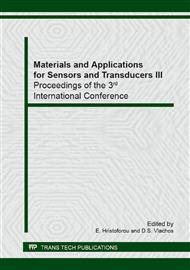p.569
p.573
p.577
p.581
p.585
p.589
p.593
p.597
p.601
Synthesis of ZnO Nanorod Arrays by Chemical Solution and Microwave Method for Sensor Application
Abstract:
One-dimensional ZnO semiconductor nanomaterials have been attracting increasing attention due to their outstanding properties, which are different from bulk materials. ZnO has a direct band gap of 3.37 eV and large exciton binding energy hence its nanowires and nanorods have been regarded as one of the most promising materials for nanoscale electronic and optoelectronic devices such as ultraviolet laser diodes, optical detectors and gas sensor. ZnO nanowires and nanorods have been successfully synthesized by various techniques such as evaporation, sputtering and pyrolysis. In this paper we report the preparation of nanorod arrays of ZnO on ITO glass substrates which were pre-coated with ZnO nanoparticles by using low temperature chemical solution method and the result was compared with microwave hydrolysis process. The morphology and structure of ZnO nanorod arrays were investigated using field emission scanning electron microscopy (FESEM) and X-ray diffraction (XRD). The ZnO nanorod arrays with a diameter of 40-70 nm were successfully synthesized. In microwave hydrolysis method, the diameter, density and surface roughness was found to depend on the microwave power. The microwave method is far superior in producing ZnO nanostructure growth.
Info:
Periodical:
Pages:
585-588
Citation:
Online since:
April 2014
Authors:
Keywords:
Price:
Сopyright:
© 2014 Trans Tech Publications Ltd. All Rights Reserved
Share:
Citation:


